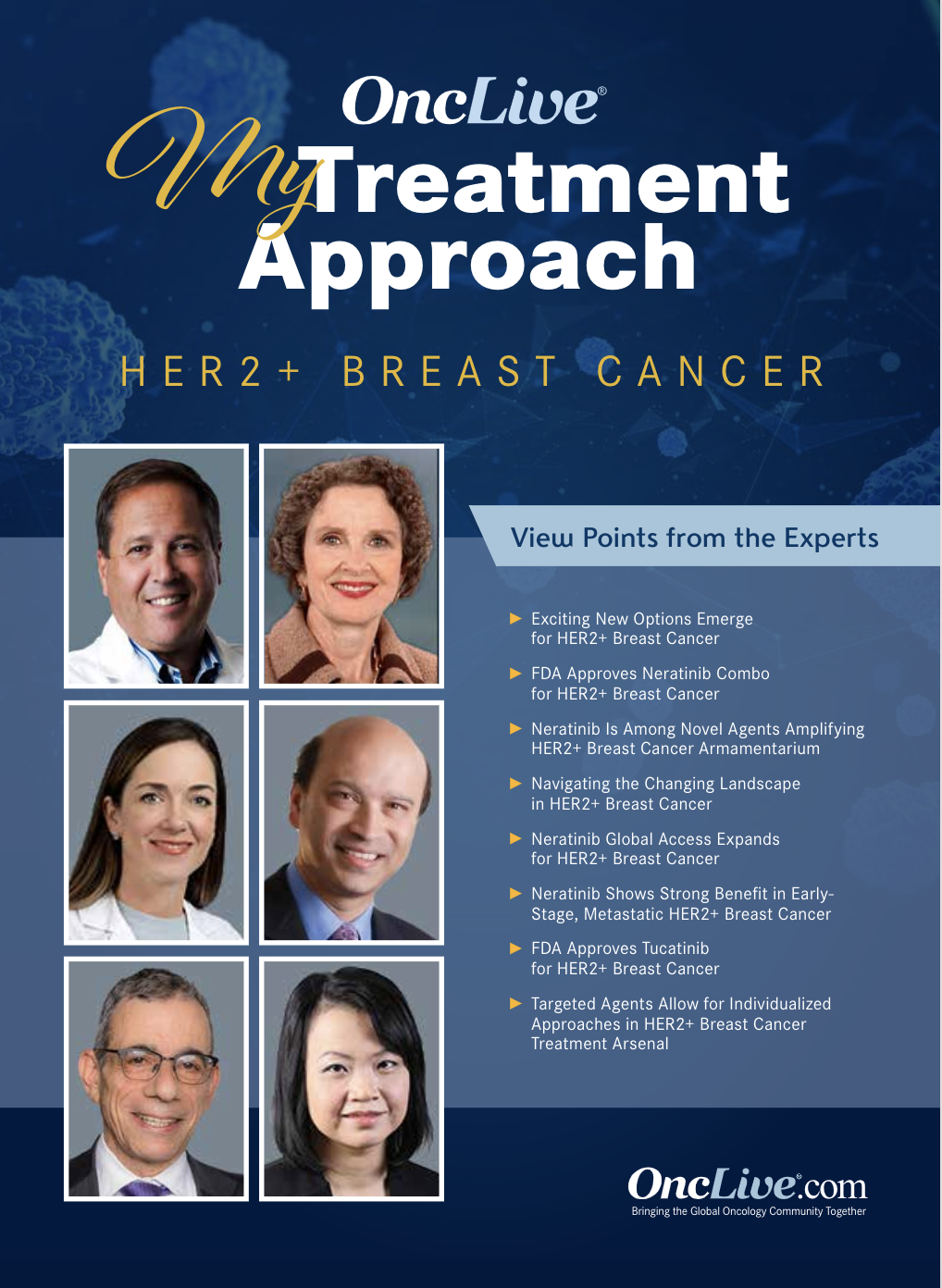Publication
Article
Supplements and Featured Publications
Neratinib Is Among Novel Agents Amplifying HER2+ Breast Cancer Armamentarium
Author(s):
Adam M. Brufsky, MD, PhD, highlightes the treatment landscape in HER2-positive breast cancer, remaining sequencing questions, and the growing utility of neratinib in the paradigm.
Adam M. Brufsky, MD, PhD, medical director of the MageeWomen's Cancer Program at the University of Pittsburgh Medical Center Hillman Cancer Center

Adam M. Brufsky, MD, PhD
Over the past few years, the armamentarium in early- and late-stage HER2-positive breast cancer has become more robust with antibody-drug conjugates (ADCs) and the pan-HER inhibitor neratinib (Nerlynx), the latter of which has emerged as a standard of care for patients with metastatic disease, said Adam M. Brufsky, MD, PhD.
In 2019, the FDA approved ado-trastuzumab emtansine (T-DM1; Kadcyla) as adjuvant therapy for patients with residual HER2-positive breast cancer following neoadjuvant trastuzumab (Herceptin) and chemotherapy. The agency also approved fam-trastuzumab deruxtecan-nxki (Enhertu; DS-8201) for patients with unresectable or metastatic HER2-positive breast cancer who have received ≥2 prior anti—HER2-based regimens in the metastatic setting.
On February 26, 2020, the FDA approved a supplemental new drug application for neratinib in combination with capecitabine (Xeloda) for the treatment of patients with advanced or metastatic HER2-positive breast cancer who have received ≥2 prior anti—HER2-based regimens in the metastatic setting, augmenting its indication as extended adjuvant therapy for patients with early HER2-positive breast cancer following trastuzumab-based therapy.
Findings from the phase III NALA trial served as the basis for the approval. Data showed a 24% reduction in the risk of disease progression or death with the neratinib combination compared with lapatinib (Tykerb) and capecitabine (HR, 0.76; 95% CI, 0.63-0.93; log-rank P value = .0059).
"The bottom line is that [neratinib] is a new standard of care if one is comfortable managing the diarrhea,” said Brufsky, who is a professor of medicine and associate division chief for the Division of Hematology/Oncology in the Department of Medicine at the University of Pittsburgh School of Medicine.
In an interview with OncLive, Brufsky, who is also codirector of the Comprehensive Breast Cancer Center at the University of Pittsburgh Medical Center Hillman Cancer Center, highlighted the treatment landscape in HER2-positive breast cancer, remaining sequencing questions, and the growing utility of neratinib in the paradigm.
OncLive: Could you shed light on the current treatment paradigm in early-stage HER2-positive breast cancer?
Brufsky: Generally, the way we treat patients with early-stage metastatic HER2-positive breast cancer is based on the size of the tumor. If the tumor is >2 cm, we tend to give neoadjuvant chemotherapy, usually with trastuzumab and pertuzumab (Perjeta). If the patient has a pathologic complete response (pCR), they will get trastuzumab or pertuzumab to complete 1 year of treatment. If they do not have a pCR, they will receive T-DM1.
For patients with tumors <1 cm, we will [perform] surgery and then make a decision about what to do. If they have tumors <2 cm and are node negative, they will likely get adjuvant paclitaxel and trastuzumab for 12 cycles or 12 weeks.
Some clinicians will give T-DM1 for 1 year, but I think that is a little controversial right now.
What options are available for patients in the adjuvant setting?
The big problem is what to do with a patient who had substantial residual disease after [surgery]. Normally, we do not give those patients 1 year of T-DM1. The problem is that data from the KATHERINE trial revealed about a 10% to 12% relapse rate, about half of which are in the central nervous system (CNS).
After T-DM1 is [completed], should these patients be given 1 year of neratinib? There are data that support this; however, [not in the context of] T-DM1 or pertuzumab. The ExteNET study showed about a 5% to 6% disease-free survival benefit in the patients who had residual disease after neoadjuvant therapy and [went on to] receive neratinib for 1 year.
Could dose-escalation strategies be used to mitigate treatment-emergent adverse events (AEs) with neratinib?
The biggest concern with [neratinib] is its toxicity, particularly diarrhea. As it turns out, there was a nice trial called CONTROL that may or may not get published in the next few months that looked at various strategies such as dose-escalation, as well as the use of colestipol, and loperamide. It turned out that a combination of dose-escalation and perhaps adding 1 of the other agents ameliorated the vast majority of diarrhea.
There will always be patients who [have significant] diarrhea, so neratinib should be used judiciously. On the other hand, there is evidence that we can ameliorate a lot of the AEs [with dose-escalation and adding other agents].
How do you approach treatment for patients with late-stage disease?
Patients with late-stage disease will likely get docetaxel, trastuzumab, and pertuzumab [to start]. If they progress, they will get T-DM1.
The real mystery right now is what to give patients after that. That [decision] is going to revolve around whether patients have brain metastases or not. If they do, we tend to try to use TKIs. I'm using neratinib and capecitabine as 1 option. It is better than lapatinib and capecitabine. At some point in the not-to-distant future, tucatinib (Tukysa), capecitabine and trastuzumab [will be another] option.
If the patient does not have substantial CNS disease, we are likely to [give] trastuzumab deruxtecan. That is really where we are going as long as we understand that a certain number of patients may get lung inflammation while on trastuzumab deruxtecan.
How have data from the NALA trial and the FDA approval of neratinib/capecitabine impacted the treatment of patients with metastatic HER2-positive breast cancer?
The combination of neratinib and capecitabine was compared with the combination of lapatinib and capecitabine in the NALA trial. Both median and mean PFS were evaluated, because it looked like the curves separated late. Because of that, median PFS is not a great end point.
It turned out there was about a 25% improvement in mean PFS in the women who received neratinib/capecitabine versus lapatinib/capecitabine—–that was statistically significant.
There was also an improvement in duration of response and time to progression [with neratinib/capecitabine]. There was also an improvement in the time to treatment failure in the brain, which was measured as the need for CNS intervention with radiation, steroids, or another modality.
The reason that end point was chosen was because we didn't require a baseline MRI to [enroll patients in] the trial. This study started around 2013, when we didn't understand that a substantial number of women had CNS progression. Had we known that, the trial would have been designed like the tucatinib studies, in which patients would have been required to have an MRI at baseline. Unfortunately, it is what it is, and we have to go with the study.
There was a clear improvement of about 10% in the number of patients who did not require CNS intervention.
While there was some grade 3 diarrhea, it only lasted about 4 days. I believe that only about 3% of patients in both arms of the trial discontinued treatment.
We will have to see what happens when tucatinib [gets approved] because that agent does not lead to diarrhea. The nice thing is that we now have an [agent in an area of] HER2-positive breast cancer, which historically didn't have a lot of proven therapies. Now, we have at least 3 agents that are going to be FDA approved.
What drugs in the pipeline look promising?
There are other drugs that are coming down the pike such as margetuximab, which is basically trastuzumab that has been reengineered to have more binding to the Fc receptor and macrophages. That [drug] may work better [than trastuzumab], but we will have to see. There are some trials that demonstrated a progression-free survival (PFS) but not an overall survival benefit [with margetuximab], so we will see [what longer-term data show].
(Vic-)trastuzumab duocarmazine (SYD985) is a similar drug. It is an ADC with a slightly different payload. It is currently in phase III clinical trials.
How has the coronavirus disease 2019 (COVID-19) pandemic impacted treatment for patients with HER2-positive breast cancer?
It is hard to know where the COVID-19 pandemic is going. The science is increasing at an enormous pace. We are doing years-worth of science and debate about varying topics in about 4 weeks.
The good thing is that it looks like the initial wave [of the pandemic] is going to resolve in the future. Our efforts are going to be centered around what we think is going on scientifically. How do we take that science and figure out how to move forward? That is the real debate.
Could neratinib be a preferred agent during the pandemic since it is an oral agent?
It's a good point for patients with metastatic disease. It is a very good idea, although patients would require close and frequent monitoring over the phone during this time.
Saura C, Oliveira M, Feng Y-H, et al. Neratinib + capecitabine versus lapatinib + capecitabine in patients with HER2+ metastatic breast cancer previously treated with ≥ 2 HER2-directed regimens: findings from the multinational, randomized, phase III NALA trial. J Clin Oncol. 2019;37(suppl 15; abstr 1002). doi: 10.1200/JCO.2019.37.15_suppl.1002










